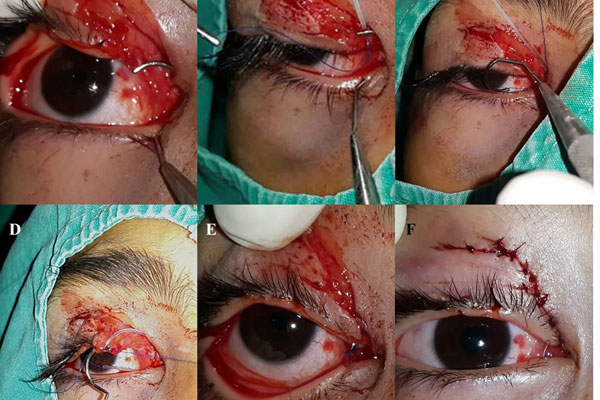The repair of canalicular lacerations with an annular silicone tube and round-tipped pigtail probe
Abstract
Purpose: To analyze the outcomes of surgical repair of canalicular lacerations with a round-tipped pigtail probe and silicone tube implantation.
Methods: A retrospective review was conducted of the case records of 64 patients who presented to the Ophthalmology Department of Harran University between 2010 and 2015 and underwent surgical repair of canalicular lacerations. Each patient’s age, gender, nationality, mechanism of injury, injured canaliculi, and follow-up time were evaluated. In addition to the anatomical and functional results, complications were also analyzed.
Results: A total of 64 patients, 51 (79.7%) males and 13 (20.3%) females, with a mean age at presentation of 14.6 years (range: 1-69 years) were enrolled. Forty-six patients were aged <15 years (71.9%). Forty-two patients (65.6%) had lower canalicular lacerations, and 19 patients had isolated upper canalicular lacerations (29.7%). At the final follow-up (mean: 33.7 months), anatomical success was observed in all patients.
Conclusion: Silicone tube implantation using a round-tipped pigtail probe is an effective method that facilitates anatomical and functional success in cases of canalicular laceration.
References
Naik MN, Kelapure A, Rath S, Honavar SG. Management of canalicular lacerations: epidemiological aspects and experience with Mini-Monoka monocanalicular stent. Am J Ophthalmol. 2008;145(2):375-380.
Reifler DM. Management of canalicular laceration. Surv Ophthalmol. 1991;36(2):113-132.
Kennedy RH, May J, Dailey J, Flanagan JC. Canalicular laceration. An 11-year epidemiologic and clinical study. Ophthal Plast Reconstr Surg. 1990;6(1):46-53.
Jones LT, Marquis MM, Vincent NJ. Lacrimal function. Am J Ophthalmol. 1972;73(5):658-659.
Quickert MH, Dryden RM. Probes for intubation in lacrimal drainage. Trans Am Acad Ophthalmol Otolaryngol. 1970;74(2):431-433.
Crawford JS. Intubation of obstructions in the lacrimal system. Can J Ophthalmol. 1977;12(4):289-292.
Fayet B, Bernard JA, Pouliquen Y. Repair of recent canalicular wounds using a monocanalicular stent. Bull Soc Ophtalmol Fr. 1989;89(6-7):819-825.
Worst JG. Method for reconstructing torn lacrimal canaliculus. Am J Ophthalmol. 1962;53:520-522.
Saunders DH, Shannon GM, Flanagan JC. The effectiveness of the pigtail probe method of repairing canalicular lacerations. Ophthalmic Surg. 1978;9(3):33-40.
Welham R. The immediate management of injuries to the lacrimal drainage apparatus. Trans Ophthalmol Soc UK. 1982;102:216.
Anderson RL, Edwards JJ. Indications, complications and results with silicone stents. Ophthalmology. 1979;86(8):1474-1487.
Jordan DR, Nerad JA, Tse DT. The pigtail probe, revisited. Ophthalmology. 1990;97(4):512-519.
Beyer CK. A modified lacrimal probe. Arch Ophthalmol. 1974;92(2):157.
Jordan DR, Gilberg S, Mawn LA. The round-tipped, eyed pigtail probe for canalicular intubation: a review of 228 patients. Ophthal Plast Reconstr Surg. 2008;24(3):176-1780.
Herzum H, Holle P, Hintschich C. Eyelid injuries: epidemiological aspects. Ophthalmologe. 2001;98(11):1079-1082.
Wulc AE, Arterberry JF. The pathogenesis of canalicular laceration. Ophthalmology. 1991;98(8):1243-1249.
Jordan DR, Ziai S, Gilberg SM, Mawn LA. Pathogenesis of canalicular lacerations. Ophthal Plast Reconstr Surg. 2008;24(5):394-398.
Ho T, Lee V. National survey on the management of lacrimal canalicular injury in the United Kingdom. Clin Exp Ophthalmol. 2006;34(1):39-43.
Linberg JV, Moore CA. Symptoms of canalicular obstruction. Ophthalmology. 1988;95(8):1077-10789.
Canavan YM, Archer DB. Long-term review of injuries to the lacrimal drainage apparatus. Trans Ophthalmol Soc UK. 1979;99(1):201-204.
Smit TJ, Mourits MP. Monocanalicular lesions: to reconstruct or not. Ophthalmology. 1999;106(7):1310-1312.
Jordan DR. To reconstruct or not. Ophthalmology. 2000;107(6):1022-1023.
Hing SJ. A retrospective study of lacrimal canaliculus injuries in Auckland. Trans Ophthalmol Soc N Z. 1984;36:72-73.
Walter WL. The use of the pigtail probe for silicone intubation of the injured canaliculus. Ophthalmic Surg. 1982;13(6):488-492.
Snead JW, Rathbun JE, Crawford JB. Effects of the silicone tube on the canaliculus: an animal experiment. Ophthalmology. 1980;87(10):1031-1036.

Copyright (c) 2020 Fatih Mehmet Adibelli, Sevim Soker Cakmak

This work is licensed under a Creative Commons Attribution 4.0 International License.
Authors who publish with this journal agree to the following terms:
- Authors retain copyright and grant the journal right of first publication, with the work twelve (12) months after publication simultaneously licensed under a Creative Commons Attribution License that allows others to share the work with an acknowledgement of the work's authorship and initial publication in this journal.
- Authors are able to enter into separate, additional contractual arrangements for the non-exclusive distribution of the journal's published version of the work (e.g., post it to an institutional repository or publish it in a book), with an acknowledgement of its initial publication in this journal.
- Authors are permitted and encouraged to post their work online (e.g., in institutional repositories or on their website) prior to and during the submission process, as it can lead to productive exchanges, as well as earlier and greater citation of published work (See The Effect of Open Access).


